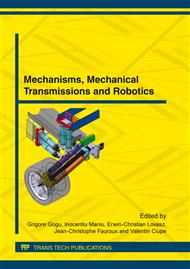p.57
p.67
p.74
p.84
p.92
p.98
p.106
p.113
p.121
Theoretical Study on Stem Implants Behaviour
Abstract:
The paper presents a complex study on hip joint endoprosthesis. The model for the femur was obtained by CT scanner and Mimics, the endoprosthesis was designed in proEngineer. This study has two stages: obtaining the 3D model for the bone and endoprosthesis, analysing the model in Ansys to obtain stress and strain state information. The paper also presents some interesting aspects of the contact between the bone and the implant in case of different types of endoprosthesis (two standardized types and one personalized). A good contact between the bone and the stem indicates a long life solution for an endoprosthesis. A personalized stem is very useful for persons with disabilities is designed taking in consideration the particularities of the patient. The contact results from Ansys illustrate the aspects from the bone stem interface. With this information the orthopaedist can take better decisions for a proper hip joint endoprosthesis used for a named patient.
Info:
Periodical:
Pages:
92-97
Citation:
Online since:
March 2012
Authors:
Keywords:
Price:
Сopyright:
© 2012 Trans Tech Publications Ltd. All Rights Reserved
Share:
Citation:


